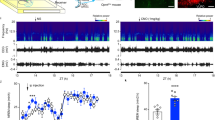Abstract
THE mammalian pineal gland has high concentrations of serotonin1–3 and of 5-hydroxytryptophan decarboxylase (5-HTPD) (ref. 4), the enzyme which synthesizes serotonin. Innervation of the rat pineal gland is derived largely or solely from sympathetic nerve fibres the cell bodies of which are located in the superior cervical ganglia5. Fluorescent microscopic findings indicate that a large part of pineal serotonin content is localized in sympathetic nerve endings2. Following superior cervical ganglionectomy, the specific indole fluorescence in these nerves disappears2 and there is a 50 per cent decrease in pineal serotonin2,3.
This is a preview of subscription content, access via your institution
Access options
Subscribe to this journal
Receive 51 print issues and online access
$199.00 per year
only $3.90 per issue
Buy this article
- Purchase on Springer Link
- Instant access to full article PDF
Prices may be subject to local taxes which are calculated during checkout
Similar content being viewed by others
References
Quay, W. B., and Halevy, A., Physiol. Zool., 35, 1 (1962).
Bertler, A., Falck, B., and Owman, C., Kungl. Fysiograf. Sallskapets I. Lund Forhandl., 33, 13 (1963).
Pellegrino de Iraldi, A., Zieher, L. M., and de Robertis, E., Life Sci., 9, 691 (1963).
Snyder, S. H., and Axelrod, J., Biochem. Pharmacol., 13, 803 (1964).
Kappers, jun., J. A., Z. Zellforsch., 52, 163 (1960).
Fiske, V. M., Bryant, G. K., and Putman, J., Endocrinol., 66, 491 (1960).
Wurtman, R. J., Axelrod, J., and Phillips, L., Science, 142, 1071 (1963).
Wurtman, R. J., Axelrod, J., and Fischer, J. E., Science, 143, 1328 (1964).
Quay, W. B., Gen. Comp. Endocrin., 3, 473 (1963).
Boura, A. L. A., and Green, A. F., Brit. J. Pharmacol., 14, 536 (1959).
Wurtman, R. J., and Axelrod, J., Biochem. Pharmacol., 12, 1439 (1963).
Maxwell, R. A., Mull, R. P., and Plummer, A. J., Experientia, 15, 267 (1959).
Cass, R., Kuntzman, R., and Brodie, B. B., Proc. Soc. Exp. Biol., 103, 871 (1960).
Cass, R., and Spriggs, T. L. B., Brit. J. Pharmacol., 17, 442 (1961).
Ferrini, R., and Glasser, A., J. Pharm. and Pharmacol., 15, 772 (1963).
Magus, R. D., Krause, F. W., and Reidel, B. E., Biochem. Pharmacol., 13, 115 (1964).
Axelrod, J., MacLean, P. D., Albers, R. W., and Weissbach, H., in Regional Neurochemistry, edit. by Kety, S. S., and Elkes, J., 307 (Pergamon, New York, 1961).
Author information
Authors and Affiliations
Rights and permissions
About this article
Cite this article
SNYDER, S., AXELROD, J., FISCHER, J. et al. Neural and Photic Regulation of 5-Hydroxytryptophan Decarboxylase in the Rat Pineal Gland. Nature 203, 981–982 (1964). https://doi.org/10.1038/203981a0
Published:
Issue Date:
DOI: https://doi.org/10.1038/203981a0
This article is cited by
-
Cryo-EM structure of the human MT1–Gi signaling complex
Nature Structural & Molecular Biology (2021)
-
Input and output signals in a model neural system: The regulation of melatonin production in the pineal gland
In Vitro (1970)
-
Superior cervical ganglionectomy in the Japanese quail
Experientia (1968)
Comments
By submitting a comment you agree to abide by our Terms and Community Guidelines. If you find something abusive or that does not comply with our terms or guidelines please flag it as inappropriate.



